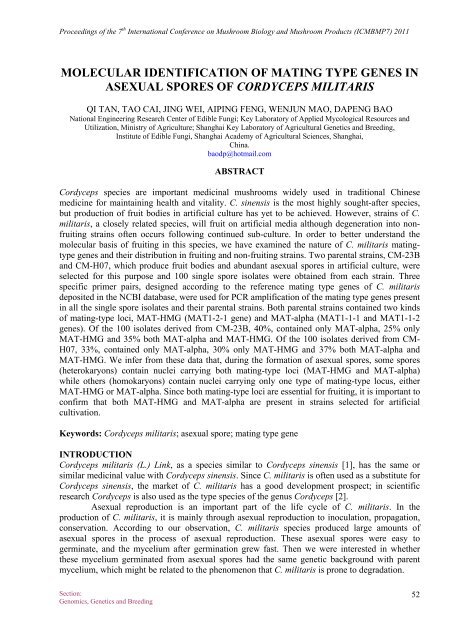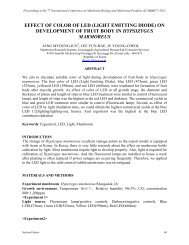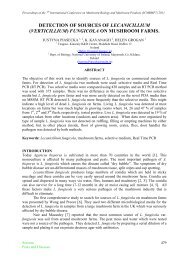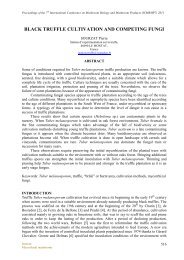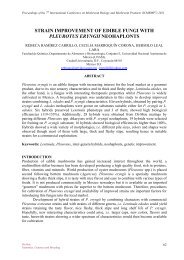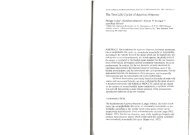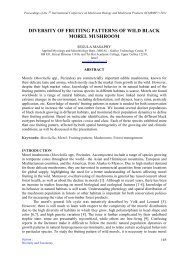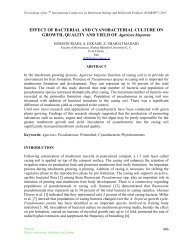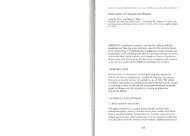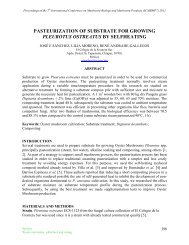Molecular identification of mating type genes in asexual spores of ...
Molecular identification of mating type genes in asexual spores of ...
Molecular identification of mating type genes in asexual spores of ...
Create successful ePaper yourself
Turn your PDF publications into a flip-book with our unique Google optimized e-Paper software.
Proceed<strong>in</strong>gs <strong>of</strong> the 7 th International Conference on Mushroom Biology and Mushroom Products (ICMBMP7) 2011<br />
MOLECULAR IDENTIFICATION OF MATING TYPE GENES IN<br />
ASEXUAL SPORES OF CORDYCEPS MILITARIS<br />
QI TAN, TAO CAI, JING WEI, AIPING FENG, WENJUN MAO, DAPENG BAO<br />
National Eng<strong>in</strong>eer<strong>in</strong>g Research Center <strong>of</strong> Edible Fungi; Key Laboratory <strong>of</strong> Applied Mycological Resources and<br />
Utilization, M<strong>in</strong>istry <strong>of</strong> Agriculture; Shanghai Key Laboratory <strong>of</strong> Agricultural Genetics and Breed<strong>in</strong>g,<br />
Institute <strong>of</strong> Edible Fungi, Shanghai Academy <strong>of</strong> Agricultural Sciences, Shanghai,<br />
Ch<strong>in</strong>a.<br />
baodp@hotmail.com<br />
ABSTRACT<br />
Cordyceps species are important medic<strong>in</strong>al mushrooms widely used <strong>in</strong> traditional Ch<strong>in</strong>ese<br />
medic<strong>in</strong>e for ma<strong>in</strong>ta<strong>in</strong><strong>in</strong>g health and vitality. C. s<strong>in</strong>ensis is the most highly sought-after species,<br />
but production <strong>of</strong> fruit bodies <strong>in</strong> artificial culture has yet to be achieved. However, stra<strong>in</strong>s <strong>of</strong> C.<br />
militaris, a closely related species, will fruit on artificial media although degeneration <strong>in</strong>to nonfruit<strong>in</strong>g<br />
stra<strong>in</strong>s <strong>of</strong>ten occurs follow<strong>in</strong>g cont<strong>in</strong>ued sub-culture. In order to better understand the<br />
molecular basis <strong>of</strong> fruit<strong>in</strong>g <strong>in</strong> this species, we have exam<strong>in</strong>ed the nature <strong>of</strong> C. militaris <strong>mat<strong>in</strong>g</strong><strong>type</strong><br />
<strong>genes</strong> and their distribution <strong>in</strong> fruit<strong>in</strong>g and non-fruit<strong>in</strong>g stra<strong>in</strong>s. Two parental stra<strong>in</strong>s, CM-23B<br />
and CM-H07, which produce fruit bodies and abundant <strong>asexual</strong> <strong>spores</strong> <strong>in</strong> artificial culture, were<br />
selected for this purpose and 100 s<strong>in</strong>gle spore isolates were obta<strong>in</strong>ed from each stra<strong>in</strong>. Three<br />
specific primer pairs, designed accord<strong>in</strong>g to the reference <strong>mat<strong>in</strong>g</strong> <strong>type</strong> <strong>genes</strong> <strong>of</strong> C. militaris<br />
deposited <strong>in</strong> the NCBI database, were used for PCR amplification <strong>of</strong> the <strong>mat<strong>in</strong>g</strong> <strong>type</strong> <strong>genes</strong> present<br />
<strong>in</strong> all the s<strong>in</strong>gle spore isolates and their parental stra<strong>in</strong>s. Both parental stra<strong>in</strong>s conta<strong>in</strong>ed two k<strong>in</strong>ds<br />
<strong>of</strong> <strong>mat<strong>in</strong>g</strong>-<strong>type</strong> loci, MAT-HMG (MAT1-2-1 gene) and MAT-alpha (MAT1-1-1 and MAT1-1-2<br />
<strong>genes</strong>). Of the 100 isolates derived from CM-23B, 40%, conta<strong>in</strong>ed only MAT-alpha, 25% only<br />
MAT-HMG and 35% both MAT-alpha and MAT-HMG. Of the 100 isolates derived from CM-<br />
H07, 33%, conta<strong>in</strong>ed only MAT-alpha, 30% only MAT-HMG and 37% both MAT-alpha and<br />
MAT-HMG. We <strong>in</strong>fer from these data that, dur<strong>in</strong>g the formation <strong>of</strong> <strong>asexual</strong> <strong>spores</strong>, some <strong>spores</strong><br />
(heterokaryons) conta<strong>in</strong> nuclei carry<strong>in</strong>g both <strong>mat<strong>in</strong>g</strong>-<strong>type</strong> loci (MAT-HMG and MAT-alpha)<br />
while others (homokaryons) conta<strong>in</strong> nuclei carry<strong>in</strong>g only one <strong>type</strong> <strong>of</strong> <strong>mat<strong>in</strong>g</strong>-<strong>type</strong> locus, either<br />
MAT-HMG or MAT-alpha. S<strong>in</strong>ce both <strong>mat<strong>in</strong>g</strong>-<strong>type</strong> loci are essential for fruit<strong>in</strong>g, it is important to<br />
confirm that both MAT-HMG and MAT-alpha are present <strong>in</strong> stra<strong>in</strong>s selected for artificial<br />
cultivation.<br />
Keywords: Cordyceps militaris; <strong>asexual</strong> spore; <strong>mat<strong>in</strong>g</strong> <strong>type</strong> gene<br />
INTRODUCTION<br />
Cordyceps militaris (L.) L<strong>in</strong>k, as a species similar to Cordyceps s<strong>in</strong>ensis [1], has the same or<br />
similar medic<strong>in</strong>al value with Cordyceps s<strong>in</strong>ensis. S<strong>in</strong>ce C. militaris is <strong>of</strong>ten used as a substitute for<br />
Cordyceps s<strong>in</strong>ensis, the market <strong>of</strong> C. militaris has a good development prospect; <strong>in</strong> scientific<br />
research Cordyceps is also used as the <strong>type</strong> species <strong>of</strong> the genus Cordyceps [2].<br />
Asexual reproduction is an important part <strong>of</strong> the life cycle <strong>of</strong> C. militaris. In the<br />
production <strong>of</strong> C. militaris, it is ma<strong>in</strong>ly through <strong>asexual</strong> reproduction to <strong>in</strong>oculation, propagation,<br />
conservation. Accord<strong>in</strong>g to our observation, C. militaris species produced large amounts <strong>of</strong><br />
<strong>asexual</strong> <strong>spores</strong> <strong>in</strong> the process <strong>of</strong> <strong>asexual</strong> reproduction. These <strong>asexual</strong> <strong>spores</strong> were easy to<br />
germ<strong>in</strong>ate, and the mycelium after germ<strong>in</strong>ation grew fast. Then we were <strong>in</strong>terested <strong>in</strong> whether<br />
these mycelium germ<strong>in</strong>ated from <strong>asexual</strong> <strong>spores</strong> had the same genetic background with parent<br />
mycelium, which might be related to the phenomenon that C. militaris is prone to degradation.<br />
Section:<br />
Genomics, Genetics and Breed<strong>in</strong>g<br />
52
Proceed<strong>in</strong>gs <strong>of</strong> the 7 th International Conference on Mushroom Biology and Mushroom Products (ICMBMP7) 2011<br />
There are two different sources <strong>mat<strong>in</strong>g</strong> <strong>type</strong> locus <strong>of</strong> Cordyceps militaris. One is <strong>mat<strong>in</strong>g</strong><br />
<strong>type</strong> loci MAT-alpha, conta<strong>in</strong>s two k<strong>in</strong>ds <strong>of</strong> <strong>mat<strong>in</strong>g</strong> <strong>type</strong> gene sequence, named MAT1-1-1 and<br />
MAT1-1-2, while the other <strong>mat<strong>in</strong>g</strong> <strong>type</strong> loci MAT-HMG conta<strong>in</strong>s only one <strong>mat<strong>in</strong>g</strong> <strong>type</strong> gene<br />
sequence, named MAT1-2-1 [3]. In the process <strong>of</strong> sexual reproduction <strong>in</strong> C. militaris,<br />
homocaryotic mycelium carry<strong>in</strong>g dist<strong>in</strong>ct <strong>mat<strong>in</strong>g</strong> <strong>type</strong> <strong>genes</strong> are compatible with each other. After<br />
plasmogamy, these compatible homocaryotic mycelia form pairs, heterocaryotic mycelium,<br />
<strong>in</strong>itiat<strong>in</strong>g the dikaryophase <strong>of</strong> the sexual cycle. Then after karyogamy and meiosis and the<br />
formation <strong>of</strong> asco<strong>spores</strong>, heterocaryons complete sexual life cycle. Accord<strong>in</strong>g to the life cycle <strong>of</strong><br />
Cordyceps militaris, homocaryotic mycelia have one <strong>type</strong> <strong>of</strong> <strong>mat<strong>in</strong>g</strong> <strong>type</strong> <strong>genes</strong>, while<br />
heterocaryotic mycelia have two <strong>type</strong>s <strong>of</strong> <strong>mat<strong>in</strong>g</strong> <strong>type</strong> <strong>genes</strong>. So we can identify the nuclear phase,<br />
homocaryon or heterocaryon, by <strong>in</strong>dentify<strong>in</strong>g the <strong>type</strong> <strong>of</strong> <strong>mat<strong>in</strong>g</strong> <strong>type</strong> <strong>genes</strong> <strong>of</strong> Cordyceps<br />
militaris.<br />
This study isolated 200 stra<strong>in</strong>s germ<strong>in</strong>ated from <strong>asexual</strong> <strong>spores</strong> <strong>of</strong> two Cordyceps<br />
militaris stra<strong>in</strong>s. We <strong>in</strong>dentified <strong>mat<strong>in</strong>g</strong> <strong>type</strong> <strong>genes</strong> <strong>of</strong> these 200 isolates by PCR.<br />
MATERIALS AND METHODS<br />
Stra<strong>in</strong>s. Cordyceps militaris stra<strong>in</strong>s, CM-23B and CM-H07, were obta<strong>in</strong>ed from Institute <strong>of</strong><br />
Edible Fungi, Shanghai Academy <strong>of</strong> Agricultural Sciences (SAAS). Cordyceps militaris mycelia<br />
cultured on potato dextrose agar medium (PDA).<br />
Preparation <strong>of</strong> <strong>asexual</strong> spore suspension and s<strong>in</strong>gle spore isolates. Stra<strong>in</strong>s were <strong>in</strong>oculated on<br />
PDA plates, 25 ℃ for 10 days dark culture. Then PDA plates covered with mycelium were<br />
washed by 1mL <strong>of</strong> sterile water to collect mycelium. Asexual <strong>spores</strong> were isolated by G-2 glass<br />
filter and suspended by sterile water and diluted to 10 5 ml -1 . 100μl spore suspension was poured<br />
onto a PDA plant. The plate was <strong>in</strong>cubated at 25 ℃ <strong>in</strong> a dark place. When visible colonies<br />
appeared, these colonies were subcultured <strong>in</strong>dividually onto fresh PDA plates, and <strong>in</strong>cubated at 25<br />
℃ <strong>in</strong> a dark place until they were covered with mycelium completely. Then these mycelium were<br />
scraped down and freeze-dried until use.<br />
Genomic DNA extraction method <strong>of</strong> Cordyceps militaris. The genomic DNA was extracted<br />
from Cordyceps militaris with the improved CTAB method [4]. Methods briefly described as<br />
follows: freeze-dried Cordyceps militaris hyphae ground to powder was added to 65℃ preheated<br />
2 x CTAB extraction liquid (2% CTAB; 1.4 M NaCl; 100mM Tris-HCl; 20mM EDTA, pH8.0),<br />
and was <strong>in</strong>cubated at 65°C at least 30 m<strong>in</strong>, then centrifuged at room temperature, 12000 rpm for<br />
10 m<strong>in</strong>. The supernatant was transferred <strong>in</strong>to another fresh 1.5 ml tube,then equivalent volume<br />
<strong>of</strong> phenol-chlor<strong>of</strong>orm(1:1) was added, mixed gently but thoroughly about 1 m<strong>in</strong>. This mixture<br />
centrifuged (12000 rpm) for 10m<strong>in</strong>. The supernatant was transferred <strong>in</strong>to another fresh 1.5 ml tube<br />
and equivalent volume <strong>of</strong> chlor<strong>of</strong>orm-isoamyl alcohol (24:1) was added, well mixed, then<br />
centrifuged (12000 rpm) for 10m<strong>in</strong>. The supernatant was transferred <strong>in</strong>to another fresh tube, and<br />
1/10 volume 3M NaAc was added, then 2/3 volume -20°C precooled isopropanol was added, and<br />
then <strong>in</strong>cubated at -20°C for 20 m<strong>in</strong>utes, centrifuged at 4℃, 12 000 rpm for 10 m<strong>in</strong>. The<br />
precipitation was washed with 75%ethanol for twice, air dried and resuspended <strong>in</strong> 30μl TE buffer.<br />
1μl RNase(10mg/ml) was added to the DNA solution for 1 hour at 37°C to remove RNA. The<br />
f<strong>in</strong>al DNA extracts were stored at -20°C until use.<br />
Specific primers amplification for identify<strong>in</strong>g <strong>mat<strong>in</strong>g</strong> <strong>type</strong> <strong>genes</strong> <strong>of</strong> Cordyceps militaris. Three<br />
specific primer pairs, shown <strong>in</strong> Table 1, designed accord<strong>in</strong>g to the reference <strong>mat<strong>in</strong>g</strong> <strong>type</strong> <strong>genes</strong> <strong>of</strong><br />
C. militaris deposited <strong>in</strong> the NCBI database(registration number AB084257 and AB194982), were<br />
used for PCR amplification <strong>of</strong> the <strong>mat<strong>in</strong>g</strong> <strong>type</strong> <strong>genes</strong> MAT1-1-2, MAT1-1-1 and MAT 1-2-1.<br />
Section:<br />
Genomics, Genetics and Breed<strong>in</strong>g<br />
53
Proceed<strong>in</strong>gs <strong>of</strong> the 7 th International Conference on Mushroom Biology and Mushroom Products (ICMBMP7) 2011<br />
Us<strong>in</strong>g s<strong>in</strong>gle spore isolates’ or their parental stra<strong>in</strong>s’ mycelia total DNA as templates, <strong>mat<strong>in</strong>g</strong> <strong>type</strong><br />
<strong>genes</strong> fragment was amplified under the follow<strong>in</strong>g conditions: PCR reaction mixture(100 μl)<br />
conta<strong>in</strong>ed 100 ng DNA, 1 x PCR buffer, 2 mmol/L Mg 2+ , 0.2 mmol/L dNTPs, 0.25 μmol/L<br />
forward and reverse primer, and 3 U Ex Taq polymerase (Takara Bio Co., Dalian). Amplification<br />
conditions were: 1 cycle <strong>of</strong> 94 °C for 2m<strong>in</strong>; 30 cycles <strong>of</strong> 94°C for 30 s, 50-55 °C (accord<strong>in</strong>g to TM<br />
<strong>of</strong> primers) for 60 s and 72 °C for 40-60 s (accord<strong>in</strong>g to the length <strong>of</strong> fragment), then a f<strong>in</strong>al<br />
extension at 72 °C for 5 m<strong>in</strong>. All amplifications were carried out us<strong>in</strong>g a TP-600 Thermal Cycler<br />
Dice (Takara). PCR products were separated on 1% (w/v) agarose gels.<br />
Table 1: Specific primers used for amplification <strong>of</strong> <strong>mat<strong>in</strong>g</strong> <strong>type</strong> <strong>genes</strong> <strong>of</strong> Cordyceps militaris<br />
Types <strong>of</strong> <strong>mat<strong>in</strong>g</strong> <strong>type</strong> <strong>genes</strong> Primers Sequences<br />
MAT112F<br />
5’- ATGGAACACAGATCGAGCGACAC<br />
-3’<br />
MAT1-1-2<br />
MAT112R<br />
5’-<br />
ATATACCTTCGCGATCATTGCCCAG -<br />
3’<br />
MAT-alpha<br />
5’- TTCAGCTTCAGTCCGTTCTGGACA<br />
MAT111F<br />
-3’<br />
MAT1-1-1<br />
5’-<br />
MAT111R GGCAGACATCGTACCTGGTCAAAT -<br />
3’<br />
5’-<br />
MAT121F ATGGATCTGCAACTGGATCGGACCA-<br />
MAT-HMG MAT1-2-1<br />
3’<br />
5’-<br />
MAT121R CTACATGATTGACTCCGGGCTCATTG-<br />
3’<br />
RESULTS AND ANALYSIS<br />
Asexual <strong>spores</strong> <strong>of</strong> Cordyceps militaris on PDA medium <strong>in</strong>itiated germ<strong>in</strong>ation easily.<br />
Generally spore germ<strong>in</strong>ation could be observed <strong>in</strong> three days after plated, and <strong>in</strong> 5 days visible<br />
small colonies could be found. The speed <strong>of</strong> spore germ<strong>in</strong>ation and hypha growth <strong>in</strong> each plate are<br />
about the same. We didn’t f<strong>in</strong>d colonies formed from <strong>spores</strong> germ<strong>in</strong>at<strong>in</strong>g slowly (Fig. 1). In this<br />
study, 100 s<strong>in</strong>gle spore isolates were obta<strong>in</strong>ed from each stra<strong>in</strong>, CM-23B and CM-H07. After<br />
subcultured <strong>in</strong>dividually onto fresh PDA plates, the hyphae grew about the same speed. We did<br />
not f<strong>in</strong>d the stra<strong>in</strong>s grew quickly or slowly obviously.<br />
After DNA extraction from 200 <strong>asexual</strong> s<strong>in</strong>gle spore isolates and their parent stra<strong>in</strong>s, their<br />
<strong>mat<strong>in</strong>g</strong> <strong>type</strong> <strong>genes</strong> were identified by PCR amplification. Fig. 2 shows the partial results <strong>of</strong><br />
<strong>identification</strong>. The length <strong>of</strong> the <strong>mat<strong>in</strong>g</strong> <strong>type</strong> gene MAT 1-1-1 was 457bp, while the length <strong>of</strong> the<br />
<strong>mat<strong>in</strong>g</strong> <strong>type</strong> gene MAT1-1-2 and MAT1-2-1 were 1063bp and 839bp, respectively.<br />
Statistical results <strong>of</strong> PCR <strong>identification</strong> showed that the parent stra<strong>in</strong>s were conta<strong>in</strong>ed two<br />
k<strong>in</strong>ds <strong>of</strong> <strong>mat<strong>in</strong>g</strong>-<strong>type</strong> loci, both MAT-alpha (MAT1-1-1 and 1-1-2) and MAT-HMG (MAT1-2-1).<br />
Of the 100 isolates derived from CM-23B, 40% , conta<strong>in</strong>ed only MAT-alpha (MAT1-1-1 and 1-1-<br />
2), 25% only MAT-HMG (MAT1-2-1) and 35% both MAT-alpha(MAT1-1-1 and 1-1-2) and<br />
MAT-HMG (MAT1-2-1) as their parent stra<strong>in</strong>s. Of the 100 isolates derived from CM-H07, 33%,<br />
conta<strong>in</strong>ed only MAT-alpha, 30% only MAT-HMG and 37% both MAT-alpha and MAT-HMG.<br />
The results are shown <strong>in</strong> Table 2.<br />
The parent stra<strong>in</strong>s are heterokaryons; each hypha cell conta<strong>in</strong>s two k<strong>in</strong>ds <strong>of</strong> the nucleus;<br />
each nucleus conta<strong>in</strong>s one <strong>type</strong> <strong>of</strong> <strong>mat<strong>in</strong>g</strong> <strong>type</strong> <strong>genes</strong>. So parent stra<strong>in</strong>s conta<strong>in</strong> both two <strong>type</strong>s <strong>of</strong><br />
<strong>mat<strong>in</strong>g</strong>-<strong>type</strong> <strong>genes</strong>. For s<strong>in</strong>gle spore isolates, 62 stra<strong>in</strong>s were the same as their parent stra<strong>in</strong>s<br />
Section:<br />
Genomics, Genetics and Breed<strong>in</strong>g<br />
54
Proceed<strong>in</strong>gs <strong>of</strong> the 7 th International Conference on Mushroom Biology and Mushroom Products (ICMBMP7) 2011<br />
conta<strong>in</strong><strong>in</strong>g two <strong>type</strong>s <strong>of</strong> <strong>mat<strong>in</strong>g</strong>-<strong>type</strong> <strong>genes</strong>. So these stra<strong>in</strong>s were believed to be heterokaryons<br />
conta<strong>in</strong><strong>in</strong>g two k<strong>in</strong>ds <strong>of</strong> nucleus. The other 138 s<strong>in</strong>gle spore isolate stra<strong>in</strong>s only conta<strong>in</strong>ed one <strong>type</strong><br />
<strong>of</strong> <strong>mat<strong>in</strong>g</strong>-<strong>type</strong> loci, which showed that their hypha cell just conta<strong>in</strong> one k<strong>in</strong>d <strong>of</strong> nucleus and they<br />
were homokaryons.<br />
Table 2: The statistical results <strong>of</strong> the k<strong>in</strong>d <strong>of</strong> <strong>mat<strong>in</strong>g</strong> <strong>type</strong> <strong>genes</strong> <strong>of</strong> <strong>asexual</strong> spore stra<strong>in</strong>s, isolated from<br />
Cordyceps militaris<br />
Types <strong>of</strong> <strong>asexual</strong><br />
spore stra<strong>in</strong>s<br />
K<strong>in</strong>ds <strong>of</strong> <strong>mat<strong>in</strong>g</strong> <strong>type</strong><br />
<strong>genes</strong><br />
stra<strong>in</strong>s derived<br />
from CM-23B<br />
stra<strong>in</strong>s derived<br />
from CM-H07<br />
Parental <strong>type</strong> MAT1-1-1, MAT1-1-2, 35 37<br />
MAT1-2-1<br />
Alpha <strong>type</strong> MAT1-1-1, MAT1-1-2 40 33<br />
HMG <strong>type</strong> MAT1-2-1 25 30<br />
Total 100 100<br />
Figure 1. The germ<strong>in</strong>ation status <strong>of</strong> <strong>asexual</strong> spore (The seventh day)<br />
750bp<br />
500bp<br />
1000bp<br />
750bp<br />
1000bp<br />
750bp<br />
M 1 2 3 4 5 6 7 8 9 10 11 12 13 14 15 16 17 18 19 20 M CK<br />
Figure 2: The partial amplification results <strong>of</strong> <strong>mat<strong>in</strong>g</strong> <strong>type</strong> <strong>genes</strong> fragment <strong>in</strong> s<strong>in</strong>gle-spore isolates (M:<br />
D2000 DNA marker; 1-20: isolates No. 1-20 from CM-23B; CK:CM-23B;A:MAT1-1-1; B:MAT1-1-<br />
2; C:MAT1-2-1)<br />
A<br />
B<br />
C<br />
Section:<br />
Genomics, Genetics and Breed<strong>in</strong>g<br />
55
Proceed<strong>in</strong>gs <strong>of</strong> the 7 th International Conference on Mushroom Biology and Mushroom Products (ICMBMP7) 2011<br />
DISCUSSION<br />
The study found that Cordyceps militaris stra<strong>in</strong>s, CM-23B and CM-H07, could produce a<br />
lot <strong>of</strong> <strong>asexual</strong> <strong>spores</strong>. We separated 200 s<strong>in</strong>gle spore isolates and <strong>in</strong>dentified their <strong>mat<strong>in</strong>g</strong> <strong>type</strong><br />
<strong>genes</strong>. We found that a lot <strong>of</strong> s<strong>in</strong>gle <strong>asexual</strong> spore isolates only conta<strong>in</strong> MAT-alpha or MAT-<br />
HMG, while their parent stra<strong>in</strong>s conta<strong>in</strong>ed both. Mat<strong>in</strong>g <strong>type</strong> <strong>genes</strong> regulate the genetic basis <strong>of</strong><br />
sexual compatibility and sexual reproduction. Cordyceps militaris is a typical bipolar<br />
heterothallism mushroom [5]. It must grow from two sexual compatible pairs, which are<br />
germ<strong>in</strong>ated from two mono-asco<strong>spores</strong>, and then dicaryons grow to the fruit<strong>in</strong>g bodies. The<br />
different degree absence <strong>of</strong> <strong>mat<strong>in</strong>g</strong> <strong>type</strong> <strong>genes</strong> <strong>of</strong> the mycelium grown from <strong>asexual</strong> <strong>spores</strong> may be<br />
the genetics reason why degeneration <strong>of</strong> Cordyceps militaris <strong>in</strong>to non-fruit<strong>in</strong>g stra<strong>in</strong>s <strong>of</strong>ten occurs<br />
follow<strong>in</strong>g cont<strong>in</strong>ued sub-culture. The question is worth further research. S<strong>in</strong>ce both <strong>mat<strong>in</strong>g</strong>-<strong>type</strong><br />
loci are essential for fruit<strong>in</strong>g, it is important to confirm that both MAT-HMG and MAT-alpha are<br />
present <strong>in</strong> stra<strong>in</strong>s selected for artificial cultivation.<br />
Accord<strong>in</strong>g to the proportion <strong>of</strong> isolates which conta<strong>in</strong>ed different k<strong>in</strong>ds <strong>of</strong> <strong>mat<strong>in</strong>g</strong> <strong>type</strong><br />
<strong>genes</strong> <strong>in</strong> this study, we supposed that the two nucleuses <strong>of</strong> Cordyceps militaris heterocaryons,<br />
conta<strong>in</strong><strong>in</strong>g MAT-alpha and MAT-HMG respectively, would be packed by plasma membrane with<br />
same probability when they formed the <strong>asexual</strong> <strong>spores</strong>. Then three k<strong>in</strong>ds <strong>of</strong> <strong>asexual</strong> <strong>spores</strong> would<br />
appear, conta<strong>in</strong><strong>in</strong>g MAT-alpha <strong>genes</strong> only and conta<strong>in</strong><strong>in</strong>g MAT-HMG only and conta<strong>in</strong><strong>in</strong>g them<br />
both. Asexual <strong>spores</strong> only conta<strong>in</strong><strong>in</strong>g MAT-alpha or MAT-HMG would grow to homocaryotic<br />
mycelia, while <strong>asexual</strong> <strong>spores</strong> conta<strong>in</strong><strong>in</strong>g both would grow to heterocaryotic mycelia. The<br />
speculation should be further affirmed by morphological observation.<br />
REFERENCES<br />
[1] Wei Wu et al. (2000). Review on Studies and Applications <strong>of</strong> Cordyceps militaris. Acta<br />
Agriculturae Shanghai. 16 (s1): 99-104.<br />
[2] Shuqian L<strong>in</strong> et al. (1997). Study on and Development <strong>of</strong> Cordyceps (Fr. ) L<strong>in</strong>k. Edible Fungi<br />
<strong>of</strong> Ch<strong>in</strong>a. (1):12<br />
[3] M<strong>in</strong>feng Li (2007). <strong>Molecular</strong> Biology Studies on the Different Pheno<strong>type</strong>s <strong>of</strong> Fruit<strong>in</strong>g-body<br />
Form<strong>in</strong>g <strong>of</strong> Cordyceps Militaris. Dissertation for Master Degree <strong>of</strong> Guizhou University.<br />
[4] Lukens L. et al. (1996). Correlation <strong>of</strong> genetic and physical maps at the A <strong>mat<strong>in</strong>g</strong> <strong>type</strong> locus <strong>of</strong><br />
Copr<strong>in</strong>us c<strong>in</strong>ereus. Genetics. 144:1471-1477.<br />
[5] X<strong>in</strong>hua GAO.(2008). Mat<strong>in</strong>g <strong>type</strong>s <strong>of</strong> Cordyceps militaris. Acta Edulis Fungi.15(1):1-5.<br />
[6 ] Me<strong>in</strong>a Li et al. (2003). <strong>Molecular</strong> analysis <strong>of</strong> degeneration <strong>of</strong> artificial planted Cordyceps<br />
militaris. Mycosystema. 22(2): 277-282.<br />
Section:<br />
Genomics, Genetics and Breed<strong>in</strong>g<br />
56


